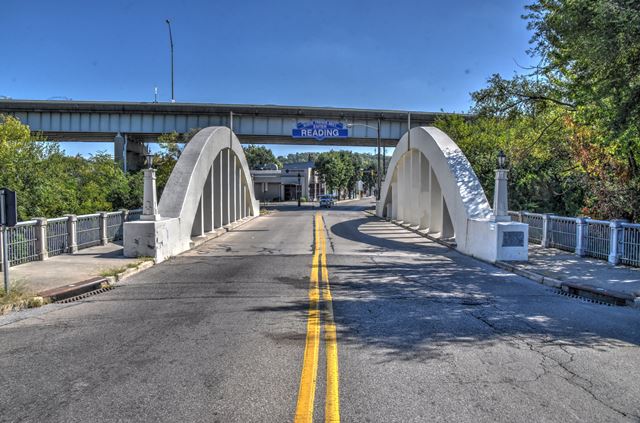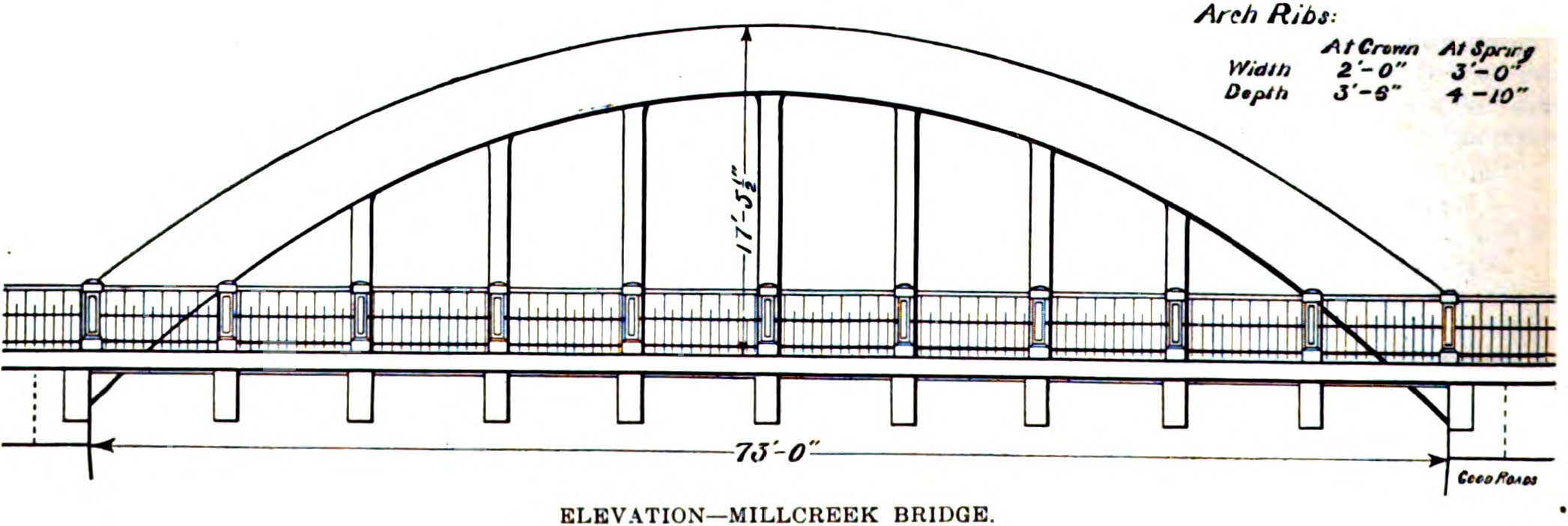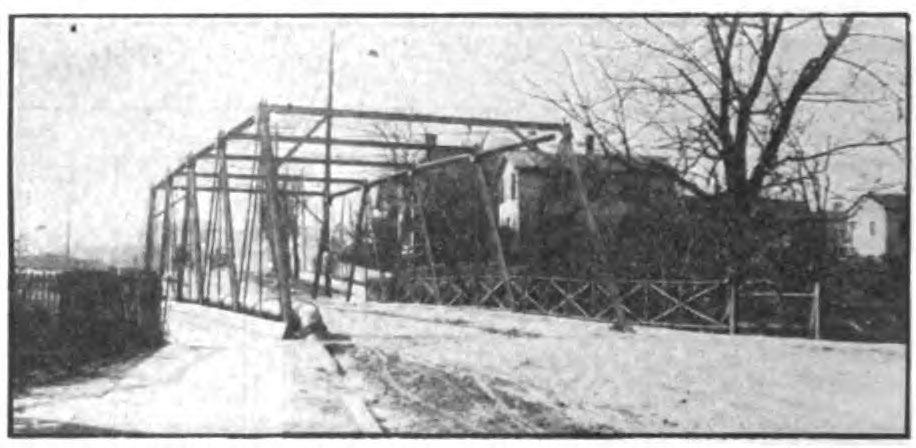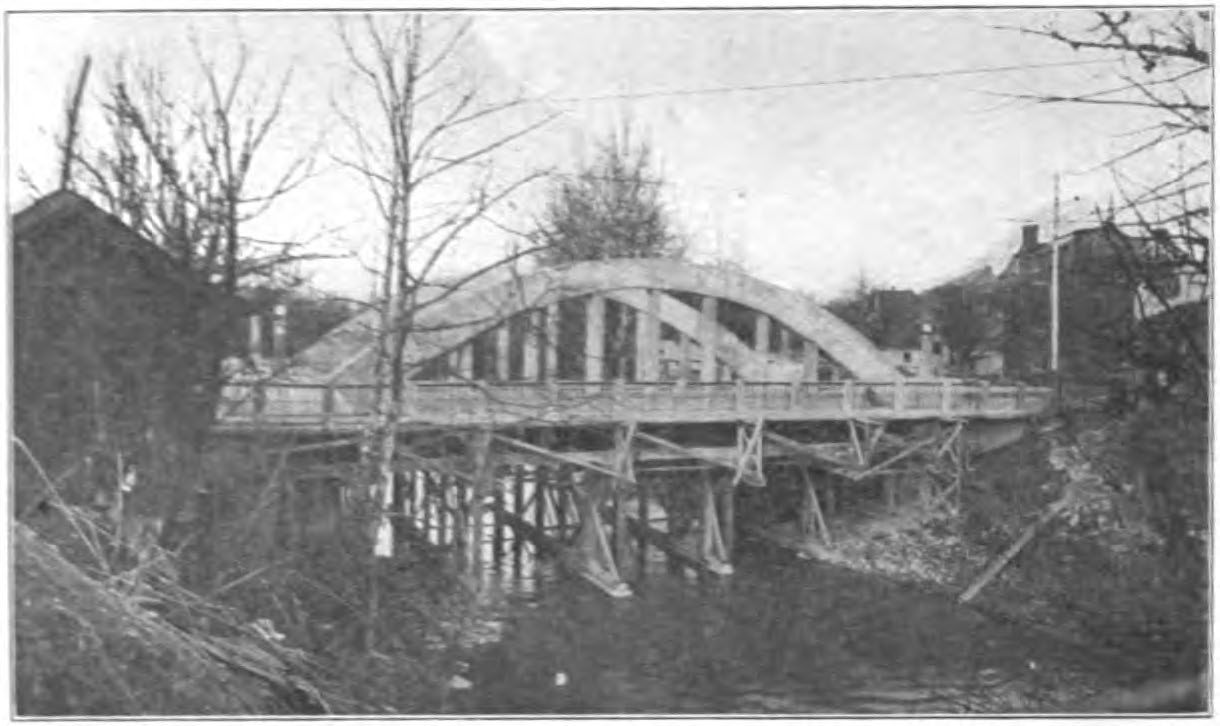We Recommend:
Bach Steel - Experts at historic truss bridge restoration.
BridgeHunter.com Phase 1 is released to the public! - Visit Now
Benson Street Bridge

Primary Photographer(s): Nathan Holth
Bridge Documented: September 22, 2019
Lockland: Hamilton County, Ohio: United States
1909 By Builder/Contractor: Unknown and Engineer/Design: E. A. Gast
1992
73.0 Feet (22.3 Meters)
100.0 Feet (30.5 Meters)
31 Feet (9.45 Meters)
1 Main Span(s)
3137600

View Information About HSR Ratings
Bridge Documentation
View Archived National Bridge Inventory Report - Has Additional Details and Evaluation
View Historic American Engineering Record (HAER) Documentation For This Bridge
HAER Data Pages, PDF
View Historical Articles About This Bridge
This may have been the first rainbow arch bridge ever built in the United States. In the same year, a similar bridge, but with diagonal members, was also built in Canada on Middle Road. Both of these bridges were built before James Barney Marsh patented his design for what is called a Marsh arch, a type of rainbow arch. The Marsh arch bridges are generally considered to be the first bridges that made the rainbow arch type of bridge popular for a while. However, both the Benson Street and Middle Road bridges, predating his patent, certainly shows that James Marsh was not the first person to design such a bridge. As such, the Benson Street Bridge is nationally significant as a prototypical example of a rainbow arch bridge, a bridge type that enjoyed popularity in some states and provinces in North America in the 1920s and 1930s.
Above: Historical photo of the previous bridge at this location, a Howe through truss with Phoenix columns, ca. 1860.
Above: Drawing showing the arrangement of reinforcing on the bridge.
Above: Historical photo showing bridge construction.
Above: Historical photo showing bridge construction.
Information and Findings From Ohio's Historic Bridge InventorySetting/Context The bridge carries a 2 lane street and sidewalks over a stream in downtown Lockland with a mix of industrial/commercial buildings dating from ca. 1890 to ca. 1960. I 75 is carried over Benson Street on a viaduct to the east of the bridge. At the northwest quadrant is a parking lot and a ca. 1960 commercial building. At the southwest quadrant is a ca. 1910, 1-story, brick commercial building with altered storefront. The City of Reading is located to the east side of the stream. Physical Description The 1 span, 100'-long, reinforced-concrete thru (rainbow) arch bridge has arch ribs with vertical reinforced-concrete hangers supporting floorbeams and a concrete deck. There are concrete pylons at the arch ends, topped by concrete light standards and lamps. The bridge has cantilevered sidewalks with galvanized pipe railings supported by concrete posts. Integrity Rehabilitated in 1992. Concrete repairs in kind, and replaced open-steel grid deck with concrete deck. Summary of Significance The 1909 rainbow arch bridge is an exceptional technologically significant example of its type/design, predating the Marsh patents, and developed by local engineer E. A. Gast. It was sensitively rehabilitated in 1992. The eligible recommendation of the prior inventory remains appropriate. It is the oldest of seven identified rainbow arches in the inventory (Phase 1A, 2008). The rainbow arch in the U.S. developed in the late 1900s and early 1910s, with its best known variation the 1912 patented design of James B. Marsh of Iowa, (which is debatably a steel arch encased in concrete). In the basic design the deck is supported by vertical hangers between the arch ribs and the floorbeams. The arch ribs, like Marsh's can have patented steel systems within them, or they can be un-patented systems of conventional reinforced concrete. The bridge type/design is known to be aesthetically pleasing and came to be popularly known as "rainbow" arches in some parts of the country, including Ohio, although technically they are perhaps best described as thru arches. The bridge type was always more numerous in the Midwest than other parts of the U.S., probably because of the influence of Marsh. The 1909 and 1911 thru arches designed by E. A. Gast in Hamilton County (3137600 & 3130622) are Ohio's oldest examples and very technologically significant as they predate the Marsh patent and are believed to have been developed independently. Later examples in Ohio are most often the design of the state bridge bureau, which developed its own standard rainbow arch by 1923. Justification The bridge is one of 5 remaining examples of the type that was once not uncommon in Ohio. It offered an aesthetic treatment preferred in urban and picturesque settings. The six examples date from 1909 to 1930, and this example has exceptional significance given that is the oldest precedent setting one in Ohio and one of the oldest known in the United States. Bridge Considered Historic By Survey: Yes |
![]()
Photo Galleries and Videos: Benson Street Bridge
Bridge Photo-Documentation
Original / Full Size PhotosA collection of overview and detail photos. This gallery offers photos in the highest available resolution and file size in a touch-friendly popup viewer.
Alternatively, Browse Without Using Viewer
![]()
Bridge Photo-Documentation
Mobile Optimized PhotosA collection of overview and detail photos. This gallery features data-friendly, fast-loading photos in a touch-friendly popup viewer.
Alternatively, Browse Without Using Viewer
![]()
Maps and Links: Benson Street Bridge
Coordinates (Latitude, Longitude):
Search For Additional Bridge Listings:
Bridgehunter.com: View listed bridges within 0.5 miles (0.8 kilometers) of this bridge.
Bridgehunter.com: View listed bridges within 10 miles (16 kilometers) of this bridge.
Additional Maps:
Google Streetview (If Available)
GeoHack (Additional Links and Coordinates)
Apple Maps (Via DuckDuckGo Search)
Apple Maps (Apple devices only)
Android: Open Location In Your Map or GPS App
Flickr Gallery (Find Nearby Photos)
Wikimedia Commons (Find Nearby Photos)
Directions Via Sygic For Android
Directions Via Sygic For iOS and Android Dolphin Browser
USGS National Map (United States Only)
Historical USGS Topo Maps (United States Only)
Historic Aerials (United States Only)
CalTopo Maps (United States Only)






